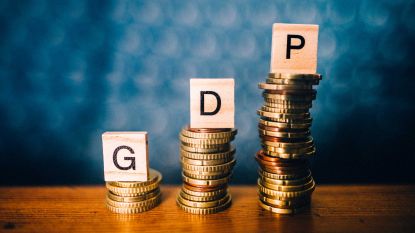GDP rebounded in the third quarter after two consecutive quarters of contraction, but experts say the rosy headline figure hides grim facts about the actual state of U.S. economic health.
The first of what will eventually be three readings of Q3 gross domestic product showed that the economy expanded at an annual rate of 2.6% in the July to September period, the Commerce Department said Thursday. That preliminary estimate topped projections for annualized growth of 2.4%.
Although the report revealed resilience on the part of American consumers and businesses, personal consumption – the largest share of the economy – expanded at 1.4% pace. That was better than economists’ average estimate but still represented a slowdown from the previous quarter.
Subscribe to Kiplinger’s Personal Finance Be a smarter, better informed investor.
Save up to 74%
Sign up for Kiplinger’s Free E-Newsletters Profit and prosper with the best of Kiplinger’s expert advice on investing, taxes, retirement, personal finance and more – straight to your e-mail.
Profit and prosper with the best of Kiplinger’s expert advice – straight to your e-mail.
GDP figures are subject to revision and can change significantly between initial estimates and final readings. It’s also true that the headline number can present a distorted picture of what’s actually going on under the hood.
To get a sense of what the experts make of the latest GDP report, below please find a selection of commentary (sometimes edited for clarity and brevity) from economists, market strategists and other financial professionals.
What the experts say:”Real GDP was slightly better than expected in the third quarter. Consumers increased spending on services, and businesses spent more on equipment and intellectual property. A smaller trade deficit was a boost to GDP, too. Consumer spending on food, energy and autos fell, and construction spending on residential and nonresidential structures were headwinds. Businesses also added less to inventories in the third quarter. While GDP was a little better than expected, the underlying trend of economic activity continues to slow. In addition, continued jobless claims rose quite a bit in mid-October, a sign that workers who lose jobs are having more trouble finding new employment. The economy will likely cool further in the near-term.” – Bill Adams, chief economist at Comerica Bank
“The U.S. economy has continued to weaken but, once again, the topline GDP number is hiding some of this weakness. In the first quarter, net exports brought down GDP growth, contributing -3.13% to economic growth. This time around it was net exports that contributed 2.77 percentage points to economic growth as exports of goods surged during the quarter even as the U.S. dollar remained strong. The Federal Reserve should look at this report with caution and remain mindful of the underlying trend for US economic growth, which shows a weakening economy.” – Eugenio Alemán, Chief Economist at Raymond James
“U.S. real GDP growth came in at +2.6% at an annual rate, and that modestly beat the +2.4% consensus estimate and interrupted the prior two quarters of contraction. This is either just a blip in a recession that started with the food and fuel inflation shock at the turn of the year, or we are set for a double-dip as the lagged impact of the Fed’s aggressive policy tightening percolates through with the classic lags.” – David Rosenberg, founder and president of Rosenberg Research
“The headline growth rate was flattered by the 2.8 percentage point boost from real net exports. However, imports likely will rebound and exports look set to weaken given clear signs of economic deceleration abroad and the strength of the dollar. Real final sales to domestic purchases, which is the sum of consumer spending and fixed investment spending, was essentially flat in the third quarter. We look for the FOMC to hike rates by another 75 bps at its meeting on November 2. We also expect the U.S. economy to slip into recession starting in the second quarter of 2023.” – Jay Bryson, Chief Economist at Wells Fargo Securities
“U.S. real GDP rebounded late summer but that doesn’t mean the economy strengthened; in fact, its underlying resilience is fraying in response to aggressive rate hikes and high inflation. Basically, the private domestic economy has stalled and looks to repeat this performance in the current quarter before contracting early next year. Despite the shiny headline number, a look under the hood shows a much grimmer picture of the U.S. economy, one that is clearly losing steam. With the full effect of past and future Fed rate hikes still to be felt, the economy appears poised for a modest downturn in the first half of next year.” – Sal Guatieri, senior economist at BMO Capital Markets
“The third quarter GDP report showed that the economy grew at an annualized rate of 2.6 percent during the quarter following a 0.6 percent decline in the second quarter. This better than expected result was driven by improvements for international trade, as exports surged during the period while imports slowed. The underlying data was a bit more mixed however, as personal consumption growth slowed during the quarter, in a sign that inflation took a toll on consumer spending. Despite the slowdown in inflationary pressure during the quarter, the report should support the Fed’s plans for an additional 75 basis point hike at their November meeting.” – Sam Millette, fixed income strategist at Commonwealth Financial Network
“The U.S. is not currently in recession, given the strength of the consumer sector. However, excluding the more volatile categories, the trajectory for growth looks weak. A deteriorating housing market and nagging inflation along with an aggressive Federal Reserve puts the economy on unsure footing for 2023. A silver lining is markets have possibly priced in much of the near-term recession risks.” – Jeffrey Roach, chief economist at LPL Financial
